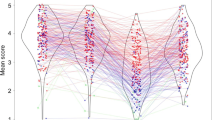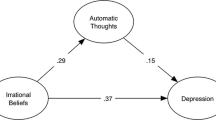Abstract
We examined two recently developed measures of positive automatic thought, the Positive Automatic Thoughts Questionnaire (ATQ-P) and the Automatic Thoughts Questionnaire—Revised (ATQ-RP). Internal consistency, concurrent validity, and convergent and discriminant validity were addressed. Two hundred one undergraduates completed self-report measures of positive automatic thoughts, negative automatic thoughts, depressive symptoms, anxiety symptoms, and positive affectivity. The ATQ-P and ATQ-RP both showed high internal consistency, strong negative associations with depressive symptoms, specificity to depressive symptoms rather than anxiety symptoms, an average state-of-mind (SOM) ratio in the positive dialogue range, and a stronger relation with each other than with a measure of positive affectivity. The only notable difference between the measures was a significantly lower mean score (correcting for number of items) on the ATQ-RP.
Similar content being viewed by others
References
Ahrens, A. H., & Haaga D. A. F. (1993). The specificity of attributional style and expectations to positive and negative affectivity, depression, and anxiety.Cognitive Therapy and Research, 17, 83–98.
Beck, A. T., Epstein, N., Brown, G., & Steer, R. A. (1988). An inventory for measuring clinical anxiety: Psychometric properties.Journal of Consulting and Clinical Psychology, 56, 893–897.
Beck, A. T., Rush A. J., Shaw, B. F., & Emery, G. (1979).Cognitive therapy of depression. New York: Guilford Press.
Beck, A. T., Steer, R. A., & Garbin, M. C. (1988). Psychometric properties of the Beck Depression Inventory: Twenty-five years of evaluation.Clinical Psychology Review, 8, 77–100.
Davison, G. C., Robins, C. & Johnson, M. K. (1983). Articulated thoughts during simulated situations: A paradigm for studying cognition in emotion and behavior.Cognitive Therapy and Research, 7, 17–40.
Dobson, K. S., & Breiter, H. J. (1983). Cognitive assessment of depression: Reliability and validity of three measures.Journal of Abnormal Psychology, 92, 107–109.
Fydrich, T., Dowdall, D. & Chambless, D. L. (1992). Reliability and validity of the Beck Anxiety Inventory.Journal of Anxiety Disorders, 6, 55–61.
Garamoni, G. L., Reynolds, C. F., Thase, M. E., Frank, E., & Fasiczka, A. L. (1992). Shifts in affective balance during cognitive therapy of major depression.Journal of Consulting and Clinical Psychology, 60, 260–266.
Heimberg, R. G., Bruch, M. A., Hope, D. A., & Dombeck, M. (1990). Evaluating the states of mind model: Comparison to an alternative model and effects of method of cognitive assessment.Cognitive Therapy and Research, 14, 543–557.
Hollon, S. D., & Kendall, P. C. (1980). Cognitive self-statements in depression: Development of an automatic thoughts questionnaire.Cognitive Therapy and Research, 4, 383–395.
Hollon, S. D., Kendall, P. C., & Lumry, A. (1986). Specificity of depressotypic cognitions in clinical depression.Journal of Abnormal Psychology, 95, 52–59.
Hurlburt, R. T. (1979). Random sampling of cognitions and behavior.Journal of Research in Personality, 13, 103–111.
Ingram, R. E. (1989). Unique and shared cognitive factors in social anxiety: Automatic thinking and self-appraisal.Journal of Social and Clinical Psychology, 8, 198–208.
Ingram, R. E., Atkinson, J. H., Slater, M. A., Saccuzzo, D. P., & Garfin, S. R. (1990). Negative and positive cognition in depressed and nondepressed chronic-pain patients.Health Psychology, 9, 300–314.
Ingram, R. E., Slater, M. A., Atkinson, J. H., & Scott, W. (1990). Positive automatic cogniti in major affective disorder.Psychological Assessment: A Journal of Consulting and Clinical Psychology, 2, 209–211.
Ingram, R. E., & Wisnicki, K. S. (1988). Assessment of positive automatic cognition.Journal of Consulting and Clinical Psychology, 56, 898–902.
Kendall, P. C. (1992). Healthy thinking.Behavior Therapy, 23, 1–11.
Kendall, P. C., Howard, B. L., & Hays, R. C. (1989). Self-referent speech and psychopathology: The balance of positive and negative thinking.Cognitive Therapy and Research, 13, 583–598.
Meng, X., Rosenthal, R., & Rubin, D. B. (1992). Comparing correlated correlation coefficients.Psychological Bulletin, 111, 172–175.
Schwartz, R. M., & Garamoni, G. L. (1986). A structural model of positive and negative states of mind: Asymmetry in the internal dialogue. In P. C. Kendall (Ed.),Advances in cognitive-behavioral research and therapy (Vol. 5, pp. 1–61). Orlando, FL: Academic Press.
Schwartz, R. M., & Garamoni, G. (1989). Cognitive balance and psychopathology: Evaluation of an information processing model of positive and negative states of mind.Clinical Psychology Review, 9, 271–294.
Watson, D., Clark, L. A., & Carey, G. (1988). Positive and negative affectivity and their relation to anxiety and depressive disorders.Journal of Abnormal Psychology, 97, 346–353.
Watson, D., Clark, L. A., & Tellegen, A. (1988). Development and validation of brief measures of positive and negative affect: The PANAS scales.Journal of Personality and Social Psychology, 54, 1063–1070.
Author information
Authors and Affiliations
Additional information
This paper is based on a thesis completed by the first author, under the supervision of the second author, in partial fulfillment of the requirements for the Master of Arts degree at American University. We are grateful to thesis committee members Lorah Dorn and Jim Gray for feedback on this material.
Rights and permissions
About this article
Cite this article
Burgess, E., Haaga, D.A.F. The positive automatic thoughts questionnaire (ATQ-P) and the automatic thoughts questionnaire—Revised (ATQ-RP): Equivalent measures of positive thinking?. Cogn Ther Res 18, 15–23 (1994). https://doi.org/10.1007/BF02359392
Issue Date:
DOI: https://doi.org/10.1007/BF02359392




